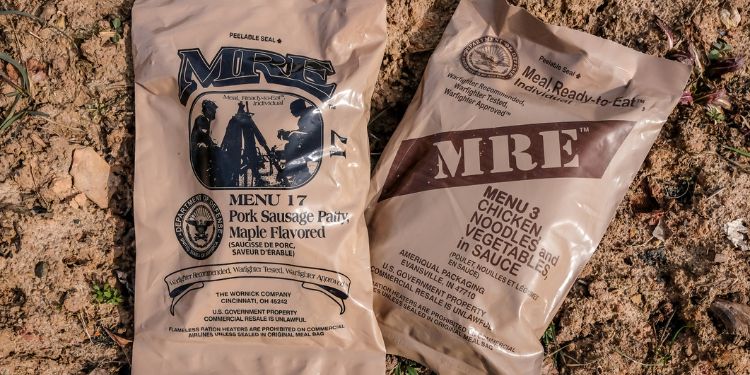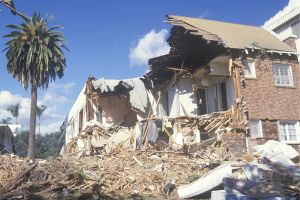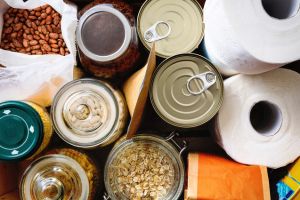
by FERGUS MASON on askaprepper.com
Food is a key part of prepping. Without a stockpile of food to keep you going through at least the initial stages of a crisis, your chances of survival are very low.
Unless you’re already completely self-sufficient – and not many of us are – you’ll be relying on that stockpile when the SHTF, so it needs to be large enough to keep you going. The question is, what should be in it?
Firstly, the kind of food you want in your survival stockpile depends on exactly what you’re planning to survive.
If you live in San Francisco and you’re putting together a stash to get you through the aftermath of an earthquake, your needs are very different to someone who’s preparing to survive the long-term collapse of civilization. In a crisis, any food is better than nothing – but the right food will make a big difference.
Let’s look at what you need in different scenarios.
Short Term Survival

Most residents of California’s earthquake hotspots take the state government’s advice and keep an emergency food supply at home, to keep them going for at least three days after a disaster. Personally I think everyone should do that. Even if you already have plenty of food at home it’s worth keeping a short-term stash in case there’s a natural disaster like a storm.
This sort of food supply should focus on food that’s energy-dense and doesn’t need much in the way of preparation. A storm or earthquake can leave large areas without power or water, so food that can be eaten cold and without rehydration is the best option here.
Military-style MREs are good; they can be eaten cold, straight out the packet, if necessary. They do taste a lot better if you can heat them, but it isn’t essential – and anyway, you can easily and safely heat them with a flameless ration heater. They’re also packed with energy, so they’ll keep you going for days.
Related: 4 Long-Lasting MREs You Should Make For Your Stockpile
A lot of bulk survival foods aren’t a good choice here. A bucket of survival food might promise 60 or 120 portions, but they won’t be very large portions; in my experience it’s best to half the number of servings the manufacturers promise, if you want to get anywhere near enough calories. They also need a lot of water, and you really don’t want to be eating cold rehydrated food – it’s pretty vile.
Instead of MREs, or as a supplement to them, look at canned foods like chili and stew. These taste better hot, but they’re palatable cold, too, and they don’t need any extra water. Pouches of tuna are good too. Add canned fruit, cookies, chocolate and candy. A nutritionist wouldn’t be happy, but this isn’t a long-term diet; it’s just meant to give you enough energy to push through the first few days after a disaster.
In this scenario, in an urban area, it’s not a luxury to have food that doesn’t need cooked; it’s essential. Even if you have a stove to cook on, damaged gas pipes could make it too dangerous to risk any kind of flame. Make sure you have enough food that can be eaten with zero preparation.
Medium Term Survival

So you’re all ready to survive for a few days if you get snowed in or the city falls down around you.
Next, what happens if there’s a nuclear war or a serious social breakdown?
Now you’re looking at having enough food to survive for weeks or even a few months.
Over this length of time, the sort of stuff in your short-term cache starts to show its limitations. For a start, it’s expensive. With MREs selling for $15 each and upwards, a three-month supply is a serious amount of money. Over this sort of time period the nutritional weaknesses of MREs and prepared snack foods start to show up.
We’re now looking at the classic prepping food supplies. Dried beans, rice and pasta should be the base of what you’re stockpiling. That gives you plenty of carbs and adequate protein. Add in cooking oil to supply fats. Canned meat, vegetables and fruit will add fiber, more protein and variety.
Salt and sugar contribute flavor and can also be used as preservatives. Don’t forget seasonings so you can produce varied, interesting meals – that makes a huge difference to morale. Flour will let you make your own bread and other baked goods. Don’t forget tea or coffee to keep you supplied with hot drinks.
Related: I Tried to Eat My Emergency Foods and This Is What Happened
In the medium term water and energy for cooking are less of a problem. You’ll still want to minimize how much you use, because they’re not limitless resources, and some survival foods aren’t naturally economical – dried beans, for example. There are ways to cut fuel use, though. For example, presoak beans to reduce cooking time.
I’m going to mention dehydrated survival food again. These do better in the medium term than as short-term emergency foods, but I’m still wary of them. They taste OK when properly prepared and served hot, but all the same problems of small portions and inadequate caloric content still apply. I wouldn’t recommend making these a major part of your stockpile. Stick to dry bulk goods and cans.
Long Term Survival

If you want to be able to stay fed indefinitely, sooner or later any stockpile is going to run out. There are long-term items that can keep you going for a year or more, until your own crops and livestock take up the slack; dried goods are key here.
Beans and rice will still be the basis of your carbohydrates.
Store as much salt and sugar as you can; producing your own isn’t easy, and you want to put that off as long as possible. Your long-term supplies need to prioritize things you can’t make easily or at all; basic protein, carbs, fiber and fats are, at some point, going to have to be hunted, foraged or raised.
Buying survival food isn’t just about buying as much food as you can and storing it in your shed or basement. You need to tailor your stockpile to suit what you think the danger is – but also keep it as flexible as possible.
If you live in a disaster-prone area and want a week’s worth of prepared food, add enough dried and canned goods to last another week if the crisis lasts longer than expected.
If your priority is long-term self-sufficiency, stockpile some MREs or prepared food just in case you have to get through a period of chaos before you can start using your main supplies. Like everything else in prepping, buying the right survival food is all about planning and making the most efficient use of your resources.
Selecting the right survival food is crucial for your preparedness strategy, yet it’s equally vital to consider sustainable, long-term solutions. Despite a well-stocked pantry, your ultimate resilience lies in getting really good at being self-sufficient, particularly in food production.
For those who are serious about surviving whatever comes their way, I strongly recommend this comprehensive guide. It offers invaluable insights and practical advice for transforming your backyard into a self-sustaining homestead.
Remember, while stockpiling food serves as a temporary fix, learning how to grow your own food ensures you can keep going for the long haul.


